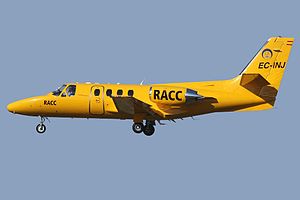Business jet manufactured 1971–1985 From Wikipedia, the free encyclopedia
The Cessna 500 Citation I is a small business jet produced by Cessna, the basis of the Citation family. The Fanjet 500 prototype was announced in October 1968, first flew on September 15, 1969, and was certified as the 500 Citation on September 9, 1971. It was upgraded in 1976 as the Citation I, and the 501 Citation I/SP single-pilot variant was introduced in 1977. Production ended in 1985 with 689 of all variants produced. The straight wing jet is powered by JT15D turbofans. The aircraft was developed into the Citation II.
| Citation I / I/SP | |
|---|---|
 | |
| A Citation I/SP | |
| Role | Corporate jet |
| National origin | United States |
| Manufacturer | Cessna |
| First flight | September 15, 1969 (FanJet 500)[1] |
| Produced | 1971–1985[2] |
| Number built | 689,[3] 688 delivered[2] |
| Variants | Cessna Citation II |

In the early 1960s, the three major American general aviation aircraft manufacturers—Beechcraft, Cessna and Piper–faced a competitive challenge in the form of two newly-developed light business jets, the Learjet 23 and the Aero Commander 1121 Jet Commander, which were much less expensive to buy and operate than previous business jets such as the North American Sabreliner and Hawker Siddeley HS.125.[4] Previous efforts by Beechcraft and Cessna to market small jets had not met with success: the Cessna 407, a proposed civil version of the T-37 Tweet jet trainer, had not proceeded past the mockup stage due to insufficient customer interest,[5] while an effort by Beechcraft to market the Morane-Saulnier MS.760 Paris in North America had ended with only two aircraft sold.[6] However, the runaway success of the Learjet caused the two companies—which only manufactured piston engined aircraft at the time—to reconsider turbine engined aircraft, and Beechcraft launched two simultaneous efforts: the development of the turboprop-powered King Air 90 and an agreement to market the HS.125 in North America.[7]
Cessna quickly found that its premium twin piston-engine aircraft were uncompetitive with the King Air, which was substantially faster, yet could be flown by pilots with similar skills and licensing qualifications. However, the company also saw a broad gap between the King Air and existing light jets such as the Learjet, which were far faster but also relatively unforgiving to fly, requiring highly skilled pilots and long runways. Cessna reasoned that a market existed for a light jet that was faster than the King Air but similarly easy to fly, relatively inexpensive to buy and maintain, and able to access small airports with shorter runways. This type of aircraft would appeal to traditional Cessna buyers: amateur owner-pilots who intend to fly the aircraft themselves.[8][citation needed]
In October 1968 Cessna announced an eight place business jet capable of operating from airfields accessible to light twins. The Fanjet 500 prototype first flew on September 15, 1969. By then its unit cost was $695,000,[1] $5.77M today. The renamed 500 Citation had a relatively long development program with a longer forward fuselage, repositioned engine nacelles, a larger tail and more dihedral to the horizontal tail. It was FAA certified on September 9, 1971.[9]
In 1974, thrust reversers became optional, and in 1976, the gross weight was increased by 1,000 pounds (450 kg) to 10,850 pounds (4,920 kg).[10] In early 1976, the wingspan was increased from 43.9 to 47.1 ft (13.4 to 14.4 m).[11] The enhanced 500 Citation I was introduced later in 1976 with the higher gross weight, improved JT15D-1A engines and the increased span wing. Speed and range were enhanced, the aircraft's service ceiling increased from 35,000 to 41,000 feet (11,000 to 12,000 m), and the cabin pressure at altitude was increased from 7.6 to 8.6 psi (52 to 59 kPa).[9][10] Many of the original Citations, of which 349 were produced, were upgraded with the new engines.[12] The 501 Citation I/SP, certificated for single pilot operations, was delivered in early 1977. Production ended in 1985, it was developed into the Citation II/Bravo and the Citation V/Ultra/Encore.[9] 395 Citations and Citation Is and 296 I/SPs were built between 1971 and 1985.[9][13] The aircraft were dropped from production because JT15D engine prices had increased to the point that the price difference between the Citation I and Citation II series had become minimal, causing most buyers to opt for the larger and faster II and II/SP.[14]
By 2018, used 1970s model 500s were valued at $300,000, Citation ISPs at $695,000 to $1.25 million with the Eagle II package.[15]

The aircraft was powered by two Pratt & Whitney Canada JT15D-1 turbofan engines after Cessna's experience with the T-37 Tweet twinjet trainer. Its use of turbofans rather than turbojets and straight wings rather than swept wings made it cruise slowly compared to other business jets and Learjet salesmen mocked it as the "Nearjet" vulnerable to "bird strikes from the rear"; Cessna renamed it the "Citation" after the thoroughbred but it was nicknamed as "Slowtation".[16]
Notable accidents and incidents involving the Citation 500, Citation I and Citation I/SP:
Data from Jane's Civil and Military Aircraft Upgrades 1994-95 [26]
General characteristics
Performance(above 28,000 ft (8,500 m)
Related development
Aircraft of comparable role, configuration, and era
Seamless Wikipedia browsing. On steroids.